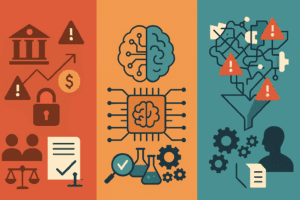Don’t Automate These Mortgage Tasks Yet
September 4, 2025
In our prior blog post, we focused on rethinking how you approach automating tasks. As an extension to that article, we thought it prudent to go a little deeper on the subject of “What kinds of tasks are not good candidates for automation.
Everyone loves a grand plan to “AI the mortgage.” The reality: some tasks still deliver poor ROI once you factor in risk, model maturity, and exception load. Below are the categories—and concrete examples—where we deliberately stay conservative, even as we automate aggressively elsewhere. We use the acronym HITL throughout to mean Human-In-The-Loop.
1) High-risk decisions where HITL wipes out the ROI
When a model mistake could trigger regulatory breaches, financial loss, or irrecoverable consumer harm, you end up with 100% review anyway—so the automation juice often isn’t worth the squeeze. This
- Funding & wire release — irreversible money movement + rampant wire-fraud attack patterns demand multi-party verification outside the model loop. Automation can prep packets; humans should still confirm final wires.
- Redisclosures/CoCs — AI can assist your CoC/redisclosure process, but putting it in the driver’s seat usually creates more risk than it saves time. Today, when a file is clean, deterministic rules can handle redisclosure; the real danger is the high cost of a bad fee or missing/inaccurate data—and current AI isn’t reliable at reconciling the data inconsistencies that often surface. Use AI to monitor deltas and draft suggested mods, but when a loan hits issues, human-in-the-loop review remains the dependable path to accuracy and compliance.
- HOEPA/HPML/QM threshold determinations — In cases like these, you must show your work and withstand an audit. The problem is not that you cannot get auditability with AI. The problem (at least with current LLMs) is that their opaque model reasoning and known LLM factuality limits raise consistency challenges and accuracy risk. There are ways to develop LLMs that can reliably deliver the consistent evaluations required of these use cases, but they require significant software coding/training. Maybe we will see vendors with deep pockets try to fill this void but the compliance evaluation bar for them will surely be steep.
Bottom line: we keep models in Draft/Recommend roles here, embed strong guardrails, and require dual control. Even regulators and industry bodies warn on explainability and accountability in high-risk financial use cases.
2) Tasks that require AI that isn’t reliable enough (or needs heavy bespoke engineering)
In these use cases, some automation is possible—but the engineering burden (guardrails, verifiers, evaluators, domain adapters) usually eats away at the value.
- Collateral valuation calls (beyond basic checks) — AVMs are now under formal quality-control standards; getting to reliable, bias-aware valuation decisions needs rigorous testing, sampling, and monitoring. Treat end-to-end “model-decide” as premature.
- Free-form handwriting, signatures, stamps on legacy scans — OCR/IDP accuracy has always been relatively low on poor-quality or handwritten artifacts. AI document intelligence is absolutely an improvement over OCR, especially since it typically gives a confidence score. It is 100% a good idea to take advantage of this capability. But know that on any risky data, you should likely turn your confidence threshold down to make sure you error on the side of safety.
- Compliance answers — there are ways to reduce hallucinations from AI, but in their current state, you don’t have to worry solely about making sure it works when you first implement it…you have to monitor it for “drift”. That is, on any compliance/risk related interaction, you will need to at least sample the responses AI has given users/customers to ensure the model has not diverged from its original training. Sound annoying? It is. But, again, without significant software coding, this is the state of the LLMs available today.
Rule of thumb: if the path to reliability is “add three more guardrails, a verifier, and nightly tests,” the ROI probably lives elsewhere first.
3) Exception-dense work where the queue won’t shrink
If 20% of the cases create 80% of the effort, full automation rarely pencils out; aim the model at using AI to assist the process not run it.
- Complex income adjudication (self-employed, K-1, variable comp) — heterogeneous docs + frequent mismatches = persistent HITL.
- State/product wrinkles and fee math (construction loans, condo/co-op quirks, prorations) — rules and overlays vary; redisclosure logic branches quickly. Even the CFPB’s own TRID materials show how nuanced these scenarios get. (Consumer Financial Protection Bureau)
- Post-close delivery cleanups with investor-specific reject codes — great for drafting fixes; still exception-heavy for final sign-off.
Play it smart: classify and extract everything, generate diffs and proposed actions, route by exception label, and reserve human time for decisions that actually change risk.
Our stance
We’re not anti-automation—we’re pro-outcomes. That’s why Brimma starts where signals are clean and rules are codifiable (documents, validations, orchestration), and stays disciplined where risk is high, AI maturity is shaky, or exceptions dominate. You’ll see better ROI by letting AI prepare and route in these zones—and letting people decide.
Want a frank read on your backlog? We’ll map each task to risk tier, model maturity, and exception load, then tell you which ones to defer, which to assist, and which to automate now.


